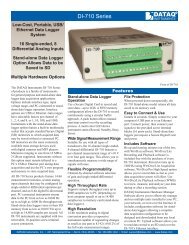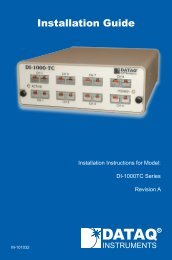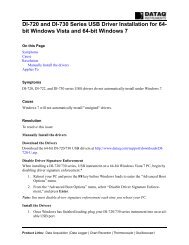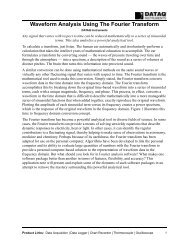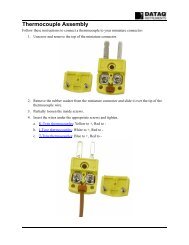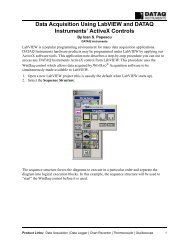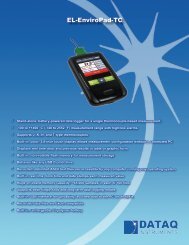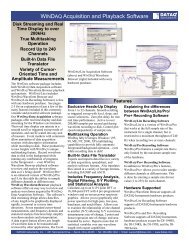DI-770 Oscilloscope provides five virtual instruments in one
DI-770 Oscilloscope provides five virtual instruments in one
DI-770 Oscilloscope provides five virtual instruments in one
Create successful ePaper yourself
Turn your PDF publications into a flip-book with our unique Google optimized e-Paper software.
<strong>DI</strong>-<strong>770</strong> and WINDAQ/Scope Manual<br />
Sett<strong>in</strong>g up a channel<br />
The two channels of the oscilloscope are completely configurable. Both channels are identical, each has its own menu<br />
item <strong>in</strong> the ma<strong>in</strong> menu. S<strong>in</strong>ce the possibilities for both channels are equal, channel 1 is expla<strong>in</strong>ed here. Where channel<br />
1 is described, the same applies to channel 2.<br />
With the menu item Ch1 (or Ch2) from the ma<strong>in</strong> menu a popup menu is called with all sett<strong>in</strong>gs for a channel.<br />
Sett<strong>in</strong>g the sensitivity of a channel<br />
The <strong>in</strong>put sensitivity of a channel determ<strong>in</strong>es how large a certa<strong>in</strong> signal will be displayed, the lower the full scale<br />
value, the larger the signal will be displayed. It is also possible to enable an autorang<strong>in</strong>g function.<br />
The sensitivity can be set through the Sensitivity menu. The Sensitivity menu is called by enabl<strong>in</strong>g the Ch1 menu and<br />
then select<strong>in</strong>g the Sensitivity menu. In this menu the <strong>in</strong>put sensitivities are available. Also an Autorang<strong>in</strong>g sett<strong>in</strong>g is<br />
available. The Sensitivity menu can also be entered by click<strong>in</strong>g the right mouse button over <strong>one</strong> of the Ch1 or Ch2<br />
controls and readouts.<br />
To switch on Autorang<strong>in</strong>g, a special button is available. When auto rang<strong>in</strong>g is switched on, the button caption is Auto,<br />
otherwise it holds the current set <strong>in</strong>put sensitivity. Press<strong>in</strong>g the right mouse button on this button will br<strong>in</strong>g up a menu<br />
with all sensitivities.<br />
Note: When autorang<strong>in</strong>g is switched on, several measurements might be needed to set the <strong>in</strong>put sensitivity, depend<strong>in</strong>g<br />
on the <strong>in</strong>put signal.<br />
Another way to set the sensitivity is by us<strong>in</strong>g the keyboard. A few keys have been reserved for sett<strong>in</strong>g the <strong>in</strong>put sensitivity<br />
of the channels. These keys are:<br />
<br />
<br />
<br />
<br />
Increase Ch1 sensitivity<br />
Decrease Ch1 sensitivity<br />
Increase Ch2 sensitivity<br />
Decrease Ch2 sensitivity<br />
Sett<strong>in</strong>g the signal coupl<strong>in</strong>g of a channel<br />
The <strong>in</strong>put signal can be coupled directly to the ADC (DC) or through a capacitor to the ADC (AC). In the hardware, a<br />
capacitor is switched <strong>in</strong>to (AC) or out of (DC) the signal path.<br />
In COUPLING DC the complete signal (AC+DC) at the <strong>in</strong>put is passed through. In COUPLING AC only the AC<br />
comp<strong>one</strong>nt of the <strong>in</strong>put signal is passed through. It is then possible to exam<strong>in</strong>e e.g. a ±20 mV ripple on a 30 V DC<br />
voltage, s<strong>in</strong>ce only the ripple is passed through and the DC voltage not. AC voltages with a frequency lower than ±4<br />
Hz are not coupled correctly.<br />
There are three different ways to set the coupl<strong>in</strong>g. Two ways are: by click<strong>in</strong>g the coupl<strong>in</strong>g button or by press<strong>in</strong>g keys.<br />
The third way is through the Signal coupl<strong>in</strong>g menu.<br />
The Signal coupl<strong>in</strong>g menu is called by enabl<strong>in</strong>g the Ch1 menu and then select<strong>in</strong>g the Signal coupl<strong>in</strong>g menu. In this<br />
menu the sett<strong>in</strong>gs Coupl<strong>in</strong>g AC and Coupl<strong>in</strong>g DC can be found. The menu can also be entered by click<strong>in</strong>g the right<br />
mouse button over <strong>one</strong> of the Ch1 or Ch2 controls and readouts.<br />
In the tool bar for each channel a coupl<strong>in</strong>g button is found, the coupl<strong>in</strong>g button for Ch1 at the left hand side of the<br />
screen, for Ch2 at the right hand side of the screen. The picture at the button <strong>in</strong>dicates the state of the coupl<strong>in</strong>g sett<strong>in</strong>g.<br />
The left button of the two buttons below is <strong>in</strong>dicat<strong>in</strong>g AC coupl<strong>in</strong>g, the right button is <strong>in</strong>dicat<strong>in</strong>g DC coupl<strong>in</strong>g.<br />
The current coupl<strong>in</strong>g state is displayed <strong>in</strong> the coupl<strong>in</strong>g button.<br />
The <strong>Oscilloscope</strong><br />
32



